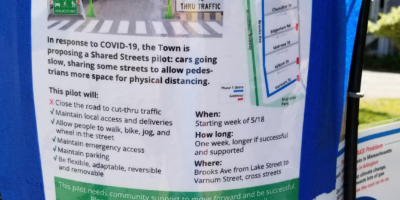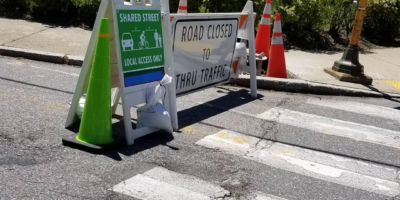Thank you to guest blogger Eileen Schroff for writing this blog on COVID-19, Open Streets and Accessibility resulting from her participation in the #SaludTues twitter chat on May 26 hosted by SaludAmerica!
Over the last few months, the spread of COVID -19 and ensuing efforts to suppress it have created abrupt changes in our everyday life. One by one, states began to limit non-essential work, travel, shopping, and social gatherings. Understandably, at the same time, transportation use changed. Stay-at-home policies led to distinctively less crowded buses, shuttles, and metros given that the close quarters of public transit pose a significant risk for virus spread.
Among the standard illness prevention methods like frequent hand washing, sanitizing high touch surfaces, and covering your mouth when coughing/sneezing, maintaining a six-foot distance has become somewhat of a mantra in coronavirus prevention. Yet the necessity, and willingness, to practice social distancing has been challenged by an opposing urge to spend time outside. Efforts to exercise, relieve stress, combat boredom, and just generally cope with so much time at home seem to be fulfilled with a dose of fresh air.
Risks and Response
It is certainly a critical moment in transportation – best visually represented by striking images of empty highways, but it’s important to remember that the transportation landscape is more than just vehicles on the road; it’s about the movement of people. So with stay-at-home orders, reduced transit services, fewer riders, fewer cars on the street, and a general slowdown of daily life, how are people moving about their spaces?
One of the biggest responses to keep people moving has been the emergence of “open streets”.
Open streets (sometimes called “shared streets”) have become popular across the country in an effort to ensure that people who leave their homes are able to do so safely. Navigating narrow sidewalks while attempting to stay six-feet from others can be somewhat of a game – adjustments of your route to avoid oncoming people, stepping onto the grass or in the street to pass ahead (sometimes unsafely), playing what seems like a game of zigzagged “sidewalk chicken” – this all in an attempt to keep a distance from other people. In many communities, open streets relieve this crowding pressure.
In their most basic form, open street initiatives are intended to give people more room in public spaces, transforming roads typically reserved for vehicles into pedestrian areas. The greater pedestrian street space, the easier it is for walkers/joggers/bikers/those using wheelchairs or mobility aids to move safely throughout a community – while maintaining appropriate distance from one another. By opening the streets to people,

Photo 1. A flyer in Arlington, MA describes their “shared streets” pilot during the week of May 18, 2020 as a response to COVID-19’s need for social distancing. The flyer‘s tagline reads “Keep it Moving, Safe Distance, Slow Speeds”. Photo Credit: Mike Flanary.
opportunities are created for safe physical activity and social engagement, while encouraging pedestrian and cycling routes as viable transportation methods.
Open streets aren’t new – they’ve been prominent in Europe for decades (NADTC’s information brief on Accessible Pedestrian Routes for Older Adults reviews some examples of international shared streets). And they’ve existed in the United States for years as well. Variations of the open street concept that may be more commonplace and familiar are wide, protected bike lanes, median greenway paths, and restricted vehicle street parking. These designs are typically very well received and appreciated in the communities in which they exist. In fact, these are often the result of community advocacy and careful planning and effort to implement them. But in the world of COVID-19, decisions that maybe would take months or years to apply, shaped by advocacy, community education, and public input, are instead happening within a matter of days, sometimes without any thoughtful consideration of the specific community in which the open street is created. Thus it becomes critical that a thorough understanding of the reasoning behind open streets, community priorities, needs, and public input are considered. Rapid street transformations, even if intended to be temporary, can have unintended consequences if not implemented carefully – sometimes at the cost of equitable access.
Considerations of Accessibility in Open Street Planning and Design
Open streets are intended to provide a greater ratio of pedestrian space to cars. Therefore pedestrian accessibility is crucial to the success of an open street, and to promote the critical elements of diversity and inclusion. Right from the start it is important to include older adults and individuals with disabilities in the planning process to ensure responsiveness to their needs and preferences – voiced from the source. Open street initiatives must be shaped by people living in closest proximity to, and in most need of, the proposed changes. If particular groups of people are excluded from the planning process, their wants & needs may not be promoted/incorporated into development. And failing to capture diversity in ages and abilities when planning for transit and urban design perpetuates exclusion in use.
When shared streets are created with equity and accessibility in mind, it allows older adults and people with disabilities to have an equal opportunity in using the shared environments. While traditional methods of gathering input are nearly impossible during this time of coronavirus, we cannot forfeit the engagement of those impacted by proposed changes (and adjustments in how engagement is conducted might mean methods such as online meetings, online surveys, phone calls, or disseminated paper feedback).
Prioritizing Accessibility within Open Streets
In the 2017, the Federal Highway Administration released a guide open street accessibility: Accessible Shared Streets: Notable Practices and Considerations for Accommodating Pedestrians with Vision Disabilities. This document includes strategies that people with vision disabilities use when navigating shared streets and ideas on how accessibility can be addressed in the planning and design process. In particular, the document notes

Photo 2. Barriers prevent traffic from entering this temporary open street in Arlington, MA, limiting the vehicles on the street to residents and employees of the immediate vicinity. Photo Credit: Mike Flanary.
“even a slight reduction in visual acuity can affect a pedestrian’s ability to negotiate with drivers and bicyclists about when to cross the street, since such communications often involve eye contact, nods, hand gestures and other visual forms of communication. Open streets can result in an ambiguous, highly variable, and potentially difficult experience for pedestrians with vision disabilities”. The subtle behavior of eye contact, nods, hand signals, and other nonverbal communications pedestrians use when navigating spaces create a disadvantage for pedestrians with vision disabilities when traditional street elements like curb ramps, sidewalk markings, and pedestrian audio signals are unavailable. It is tremendously important to consider these, and other potential navigational challenges that individuals may face, when implementing open streets.
Equity
Equity is truly about all people – regardless of age/race/ability/income – being considered in open streets planning and decision making. We’d be remiss in this discussion to fail to acknowledge how open streets may not provide any relief to the most pressing issues that some vulnerable communities are facing. Many Black communities are currently struggling with disproportionately high COVID-19 cases and death rates while simultaneously fighting against systemic oppression and racism.
Coronavirus has given many communities across the country an introduction to experience open streets. But creating open streets may not actually address any of the long-standing concerns around the transportation needs of a given community. An open street where planning isn’t carefully evaluated may not fulfill its intended role at all. But providing residents with an opportunity to voice desires and needs can help shape the open street movement and prioritize goals, embracing civic engagement values and furthering equity in the experience of public spaces.
By way of the open streets movement, people can demand the expansion of safe and welcoming environments. Ultimately, open streets can create dialogue to discuss other issues of equity that intersect with transportation like racism, access to healthcare, food insecurity, and housing.
What’s Next?
While many of these open street interventions are temporary, some are wondering if open streets can be a viable and safe strategy long term – or at the very least lead to conversations about street design solutions to create community change. It’s critical, though, that when considering open streets that a thoughtful, local approach is taken – an approach that considers community needs, prioritizes accessibility, welcomes all people, and fosters lasting neighborhood vitality. Everyone deserves safe places to be physically active and safe routes to get to essential destinations. The changes and conversations happening today may be just what our future needs.
Eileen Schroff is an independent consultant and a contractor for the National Aging and Disability Transportation Center. Her experience includes four years at the National Association of Area Agencies on Aging (n4a), providing support to n4a’s transportation projects, including the NADTC. She is passionate about bringing attention to the transportation challenges of older adults and people with disabilities and providing opportunities for dialogue and open discussion around potential solutions and best practices in the field.
Leave a Reply